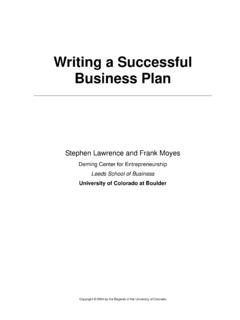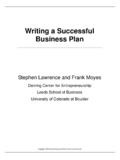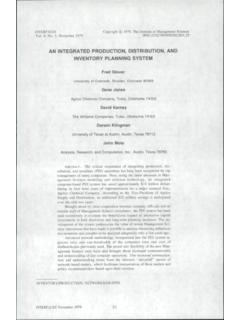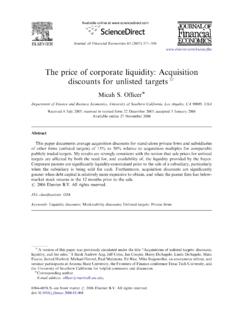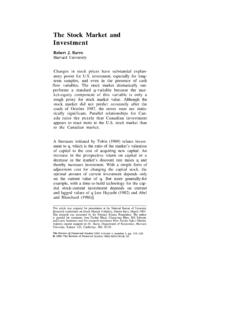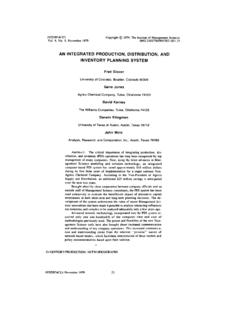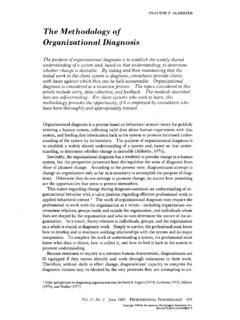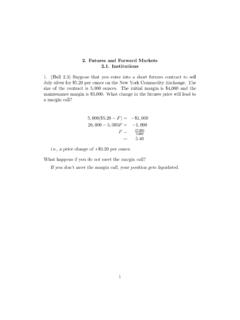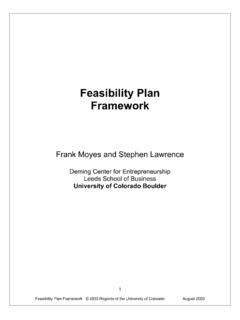Transcription of A Tutorial on Formulating and Using QUBO Models
1 A Tutorial on Formulating and Using QUBO Models Fred Glover1, Gary Kochenberger2, Yu Du2. May 2019. Abstract The Quadratic Unconstrained Binary Optimization (QUBO) model has gained prominence in recent years with the discovery that it unifies a rich variety of combinatorial optimization problems. By its association with the Ising problem in physics, the QUBO model has emerged as an underpinning of the quantum computing area known as quantum annealing and has become a subject of study in neuromorphic computing.
2 Through these connections, QUBO Models lie at the heart of experimentation carried out with quantum computers developed by D-Wave Systems and neuromorphic computers developed by IBM. The consequences of these new computational technologies and their links to QUBO Models are being explored in initiatives by organizations such as Google, Amazon and Lockheed Martin in the commercial realm and Los Alamos National Laboratory, Oak Ridge National Laboratory, Lawrence Livermore National Laboratory and NASA's Ames Research Center in the public sector.
3 Computational experience is being amassed by both the classical and the quantum computing communities that highlights not only the potential of the QUBO model but also its effectiveness as an alternative to traditional modeling and solution methodologies. This Tutorial discloses the basic features of the QUBO model that give it the power and flexibility to encompass the range of applications that have thrust it onto center stage of the optimization field. We show how many different types of constraining relationships arising in practice can be embodied within the unconstrained QUBO formulation in a very natural manner Using penalty functions, yielding exact model representations in contrast to the approximate representations produced by customary uses of penalty functions.
4 Each step of generating such Models is illustrated in detail by simple numerical examples, to highlight the convenience of Using QUBO. Models in numerous settings. We also describe recent innovations for solving QUBO Models that offer a fertile avenue for integrating classical and quantum computing and for applying these Models in machine learning. 1. ECEE, College of Engineering and Applied Science, University of Colorado, Boulder, CO. 80302 USA 2. College of Business, University of Colorado at Denver, Denver, CO 80217 USA, 1.
5 Table of Contents: Section 1: Introduction Overview and Basic Formulation Section 2: Illustrative Examples and Definitions Examples Definitions Section 3: Natural QUBO Formulations The Number Partitioning Problem The Max Cut Problem Section 4: Creating QUBO Models Using Known Penalties Frequently Used Penalties The Minimum Vertex Cover Problem The Set Packing Problem The Max 2-Sat Problem Section 5: Creating QUBO Models Using a General Purpose Approach General transformation The Set Partitioning Problem The Graph Coloring Problem The General 0/1 Linear Model The Quadratic Assignment Problem The Quadratic Knapsack Problem Section 6: Connections with Quantum Computing and Machine Learning Quantum Computing QUBO Developments Unsupervised Machine Learning with QUBO.
6 Supervised Machine Learning with QUBO. Machine Learning to Improve QUBO Solution Processes Section 7: Concluding Remarks Bibliography Acknowledgments 2. Section 1: Introduction The field of Combinatorial Optimization (CO) is one of the most important areas in the field of optimization, with practical applications found in every industry, including both the private and public sectors. It is also one of the most active research areas pursued by the research communities of Operations Research, Computer Science and Analytics as they work to design and test new methods for solving real world CO problems.
7 Generally, these problems are concerned with making wise choices in settings where a large number of yes/no decisions must be made and each set of decisions yields a corresponding objective function value like a cost or profit value. Finding good solutions in these settings is extremely difficult. The traditional approach is for the analyst to develop a solution algorithm that is tailored to the mathematical structure of the problem at hand. While this approach has produced good results in certain problem settings, it has the disadvantage that the diversity of applications arising in practice requires the creation of a diversity of solution techniques, each with limited application outside their original intended use.
8 In recent years, we have discovered that a mathematical formulation known as QUBO, an acronym for a Quadratic Unconstrained Binary Optimization problem, can embrace an exceptional variety of important CO problems found in industry, science and government, as documented in studies such as Kochenberger, et. al. (2014) and Anthony, et. al. (2017). Through special reformulation techniques that are easy to apply, the power of QUBO solvers can be used to efficiently solve many important problems once they are put into the QUBO framework.
9 This two-step process of first re-casting an original model into the form of a QUBO model and then solving it with appropriate software enables the QUBO model to become a unifying framework for combinatorial optimization. The alternative path that results for effectively modeling and solving many important problems is a new development in the field of combinatorial optimization. The significance of this situation is enhanced by the fact that the QUBO model can be shown to be equivalent to the Ising model that plays a prominent role in physics, as highlighted in in the paper by Lucas (2014).
10 Consequently, the broad range of optimization problems solved effectively by state-of-the-art QUBO solution methods are joined by an important domain of problems arising in physics applications. 3. The materials provided in the sections that follow illustrate the process of reformulating important optimization problems as QUBO Models through a series of explicit examples. Collectively these examples highlight the application breadth of the QUBO model. We disclose the unexpected advantages of modeling a wide range of problems in a form that differs from the linear Models classically adopted in the optimization community.
